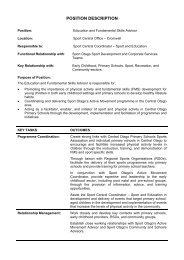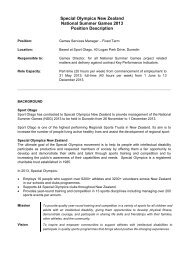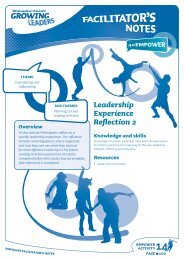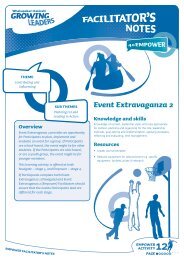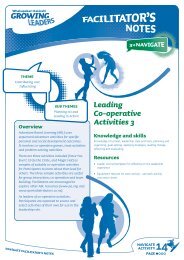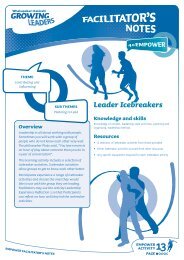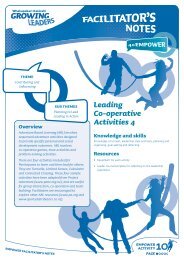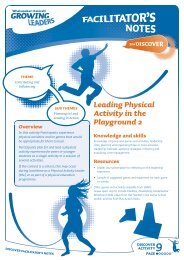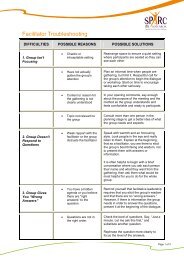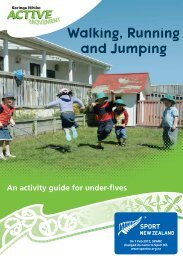Read Getting Set for an Active Nation - Sport New Zealand
Read Getting Set for an Active Nation - Sport New Zealand
Read Getting Set for an Active Nation - Sport New Zealand
You also want an ePaper? Increase the reach of your titles
YUMPU automatically turns print PDFs into web optimized ePapers that Google loves.
12= Suicide Depression, stress<br />
14 Osteoporosis Obesity, physical inactivity<br />
15 Lower respiratory/tract infection Lack of vaccination, pneumonia,<br />
influenza<br />
Source: The <strong>New</strong> Zeal<strong>an</strong>d Herald 21/01/2000 graphic from in<strong>for</strong>mation supplied by Ministry of Health<br />
• “A comprehensive literature review conducted by a research team at the University<br />
of Alberta indicated that since 1990, over 1500 scientific studies have been<br />
published that positively link physical activity <strong>an</strong>d health (CFLRI, 1995). Thirtyeight<br />
different types of positive health outcomes were identified r<strong>an</strong>ging from<br />
symptom m<strong>an</strong>agement of Alzheimer’s patients to pain control in osteoarthritis. In<br />
that report, six major positive health outcomes were identified:<br />
- The slowing of m<strong>an</strong>y <strong>for</strong>ms of physical decline by up to 50%.<br />
- Prospects <strong>for</strong> increasing social networks through active living.<br />
- Enh<strong>an</strong>cement of various cognitive <strong>an</strong>d neurological functions of the brain.<br />
- Early detection of disease.<br />
- More rapid recovery following a bout of serious illness.<br />
- Probability that the immune system will function at a more optimal level<br />
thereby maximising protection against m<strong>an</strong>y serious ailments” (C<strong>an</strong>adi<strong>an</strong> Parks/<br />
Recreation Association, 1998, p.4).<br />
• A p<strong>an</strong>el of experts, convened by the United States Centers <strong>for</strong> Disease Control <strong>an</strong>d<br />
the Americ<strong>an</strong> College of <strong>Sport</strong>s Medicine, recommended 30 minutes of moderateintensity<br />
exercise (such as brisk walking or cycling) each day to achieve the health<br />
benefits from physical activity (Pate, Pratt <strong>an</strong>d Blair, 1995). This signalled a<br />
departure from earlier recommendations of three sessions a week. This approach<br />
has also been adopted by the <strong>Nation</strong>al Heart Foundation of Australia (Baum<strong>an</strong>,<br />
Wright <strong>an</strong>d Brown, 2000) <strong>an</strong>d the Department of Health in Britain (1995). There is<br />
reasonable evidence that the 30 minutes c<strong>an</strong> be accumulated through several<br />
shorter sessions (Lee, Sesso <strong>an</strong>d Paffenbarger, 2000).<br />
C<strong>an</strong>cer<br />
• “At least a dozen studies have found a link between exercise <strong>an</strong>d reduced risk of<br />
breast c<strong>an</strong>cer.” The latest, conducted by Dr. Inger Thune <strong>an</strong>d others from the<br />
University of Tromso, followed 25,624 women in the 1970s <strong>an</strong>d early 1980s. After<br />
<strong>an</strong> average of 14 years, 351 of these women developed breast c<strong>an</strong>cer. Researchers<br />
found that, after they took into consideration a wom<strong>an</strong>’s weight, pregn<strong>an</strong>cy<br />
histories <strong>an</strong>d other factors, those who got regular exercise (at least four hours a<br />
week) developed signific<strong>an</strong>tly less breast c<strong>an</strong>cer (Thune, 1997, cited in C<strong>an</strong>adi<strong>an</strong><br />
Parks/Recreation Association, 1998, p.17).<br />
• Physical inactivity has been shown to be a risk factor in the development of breast<br />
c<strong>an</strong>cer (Verloop, Rookus, v<strong>an</strong> der Kooy <strong>an</strong>d v<strong>an</strong> der Leeuwen, 2000).<br />
• Although the mech<strong>an</strong>ism is not completely understood, there is a clear beneficial<br />
effect of physical activity on the prevention of bowel c<strong>an</strong>cer (Colditz, C<strong>an</strong>nuscio<br />
Ministerial Task<strong>for</strong>ce on <strong>Sport</strong>, Fitness & Leisure J<strong>an</strong>uary 2001 page 39 of 153




